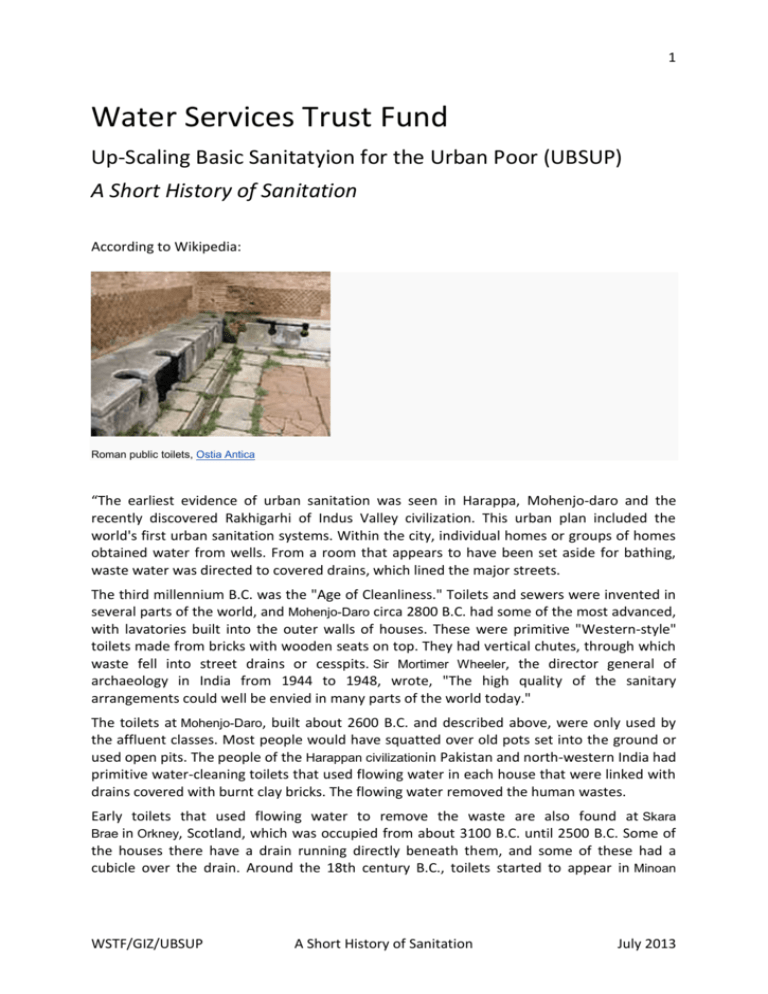7. A Short History of Sanitation
advertisement

1 Water Services Trust Fund Up-Scaling Basic Sanitatyion for the Urban Poor (UBSUP) A Short History of Sanitation According to Wikipedia: Roman public toilets, Ostia Antica “The earliest evidence of urban sanitation was seen in Harappa, Mohenjo-daro and the recently discovered Rakhigarhi of Indus Valley civilization. This urban plan included the world's first urban sanitation systems. Within the city, individual homes or groups of homes obtained water from wells. From a room that appears to have been set aside for bathing, waste water was directed to covered drains, which lined the major streets. The third millennium B.C. was the "Age of Cleanliness." Toilets and sewers were invented in several parts of the world, and Mohenjo-Daro circa 2800 B.C. had some of the most advanced, with lavatories built into the outer walls of houses. These were primitive "Western-style" toilets made from bricks with wooden seats on top. They had vertical chutes, through which waste fell into street drains or cesspits. Sir Mortimer Wheeler, the director general of archaeology in India from 1944 to 1948, wrote, "The high quality of the sanitary arrangements could well be envied in many parts of the world today." The toilets at Mohenjo-Daro, built about 2600 B.C. and described above, were only used by the affluent classes. Most people would have squatted over old pots set into the ground or used open pits. The people of the Harappan civilizationin Pakistan and north-western India had primitive water-cleaning toilets that used flowing water in each house that were linked with drains covered with burnt clay bricks. The flowing water removed the human wastes. Early toilets that used flowing water to remove the waste are also found at Skara Brae in Orkney, Scotland, which was occupied from about 3100 B.C. until 2500 B.C. Some of the houses there have a drain running directly beneath them, and some of these had a cubicle over the drain. Around the 18th century B.C., toilets started to appear in Minoan WSTF/GIZ/UBSUP A Short History of Sanitation July 2013 2 Crete; Egyptin the time of the Pharaohs and ancient Persia. In Roman civilization, toilets using flowing water were sometimes part of public bath houses. Roman toilets, like the ones pictured here, are commonly thought to have been used in the sitting position. But sitting toilets only came into general use in the mid-19th century in the western world. The Roman toilets were probably elevated to raise them above open sewers which were periodically "flushed" with flowing water, rather than elevated for sitting. Squat toilets (also known as an Arabic, French, Chinese, Japanese, Korean, Iranian, Indian, Turkish or Natural-Position toilet) is a toilet used by squatting, rather than sitting and are still used by the majority of the world's population. There are several types of squat toilets, but they all consist essentially of a hole in the ground or floor with various provisions for human waste. 1. Sanitation in Ancient Rome Roman cities and Roman villas had elements of sanitation systems, delivering water in the streets of towns such as Pompeii, and building stone and wooden drains to collect and remove wastewater from populated areas - see for instance the Cloaca Maxima into the River Tiber in Rome. But there is little record of other sanitation in most of Europe until the High Middle Ages. Unsanitary conditions and overcrowding were widespread throughout Europe and Asia during the Middle Ages, resulting periodically in cataclysmic pandemics such as the Plague of Justinian (541-42) and the Black Death (1347–1351), which killed tens of millions of people and radically altered societies. Very high infant and child mortality prevailed in Europe throughout medieval times, due not only to deficiencies in sanitation but to an insufficient food supply for a population which had expanded faster than agriculture. This was further complicated by frequent warfare and exploitation of civilians by autocratic rulers. Sanitation refers to the safe disposal of human excreta (Mara, Lane and Scott and Trouba,1). This entails the hygienic disposal and treatment of human waste to avoid affecting the health of people. Sanitation is an essential part of the Millennium Development Goals. The most affected countries are in the developing world (Zawahri, Sowers, and Weinthal 1153). Population increase in the developing world has posed challenges in the improvement of sanitation (Konteh 69). According to Zawari, Sowers, and Weinthal (1154), lack of provisions of basic sanitation is estimated to have contributed to the deaths of approximately 3.5 million people annually from water borne diseases. Sanitation in ancient Rome was a complex system similar in many ways to modern sanitation systems. During the Dark Ages, the technical knowledge of the Roman system was lost and has subsequently been investigated by modern-era historians and archeologists. Sewer system The latrines are the best-preserved feature at Homesteads Roman Fort on Hadrian's Wall. The soldiers sat on wooden boards with holes, which covered the two big trenches. Water ran in the two small ditches at the soldiers' feet. WSTF/GIZ/UBSUP A Short History of Sanitation July 2013 3 A system of thirteen aqueducts provided the inhabitants of Rome with water of varying quality, the best being reserved for potable supplies. Poorer-quality water was used in the public baths and in the latrines, which were an early form of toilet. Latrine systems have been found in many places, such as House-steads, a Roman fort on Hadrian's Wall, in Pompeii, Herculaneum, and elsewhere that flushed waste away with a stream of water. Romans used sea sponges on sticks after defecation. The latrines are the best-preserved feature at Housesteads Roman Fort onHadrian's Wall. The soldiers sat on wooden boards with holes, which covered the two big trenches. Water ran in the two small ditches at the soldiers' feet. The Romans had a complex system of sewers covered by stones, much like modern sewers. Waste flushed from the latrines flowed through a central channel into the main sewage system and thence into a nearby river or stream. However, it was not uncommon for Romans to throw waste out of windows into the streets, at least according to Roman satirists. Despite this, Roman waste management is admired for its innovation. It is estimated that the first sewers of ancient Rome were built between 800 and 735 BC. Drainage systems evolved slowly, and began primarily as a means to drain marshes and storm runoff. The sewers were mainly for the removal of surface drainage and underground water (Farnsworth, p. 942). The sewage system as a whole did not really take off until the arrival of the Cloaca Maxima, an open channel that was later covered, and one of the bestknown sanitation artifacts of the ancient world. Most sources believe it was built during the reign of the three Etruscan kings in the sixth century BC. This "greatest sewer" of Rome was originally built to drain the low-lying land around the Forum. It is not known how effective the sewers were, especially in removing excrement. (Gowers, p. 27). From very early times the Romans, in imitation of the Etruscans, built underground channels to drain rainwater that might otherwise wash away precious top-soil, used ditches to drain swamps (such as the Pontine marshes), and dug subterranean channels to drain marshy areas. Over time, the Romans expanded the network of sewers that ran through the city and linked most of them, including some drains, to the Cloaca Maxima, which emptied into the Tiber River. In 33 BC, under the emperor Augustus, the Cloaca Maxima was enclosed, creating a large tunnel. The Cloaca Maxima, it is presumed, built in the fourth century BC and reconstructed under Augustus), still drains the Forum Romanum and surrounding hills. Strabo, a Greek author who lived from about 60 BC to AD 24, admired the ingenuity of the Romans in his Geographica, writing: WSTF/GIZ/UBSUP A Short History of Sanitation July 2013 4 The sewers, covered with a vault of tightly fitted stones, have room in some places for hay wagons to drive through them. And the quantity of water brought into the city by aqueducts is so great that rivers, as it were, flow through the city and the sewers; almost every house has water tanks, and service pipes, and plentiful streams of water...In short, the ancient Romans gave little thought to the beauty of Rome because they were occupied with other, greater and more necessary matters. Stone pipes A law was eventually passed to protect innocent bystanders from assault by wastes thrown into the street. The violator was forced to pay damages to whomever his waste hit, if that person sustained an injury. This law was enforced only in the day-time, it is presumed because one then lacked the excuse of darkness for injuring another by careless waste disposal. Around AD 100, direct connections of homes to sewers began, and the Romans completed most of the sewer system infrastructure. Sewers were laid throughout the city, serving public and some private latrines, and also served as dumping grounds for homes not directly connected to a sewer. It was mostly the wealthy whose homes were connected to the sewers, through outlets that ran under an extension of the latrine. Public latrines In general, the poor used pots that they were supposed to empty into the sewer, or visited public latrines. Public latrines date back to the 2nd century BC. Whether intentionally or not, they became places to socialise. Long bench-like seats with keyhole-shaped openings cut in rows offered little privacy. Some latrines were free, for others small charges were made (Amulree, p. 247). According to Lord Amulree, the site where Julius Caesar was assassinated, the Hall of Curia in the Theatre of Pompey, was turned into a public latrine because of the dishonor it had witnessed. The sewer system, like a little stream or river, ran beneath it, carrying the wastes away to the Cloaca Maxima. The Romans recycled public bath waste water by using it as part of the flow that flushed the latrines. Terra cotta piping was used in the plumbing that carried waste water from homes. WSTF/GIZ/UBSUP A Short History of Sanitation July 2013 5 The Romans were the first to seal pipes in concrete to resist the high water pressures developed in siphons and elsewhere. Beginning around the 5th century BC, city officials called aediles supervised the sanitary systems. They were responsible for the efficiency of the drainage and sewage systems, the cleansing and paving of the streets, prevention of foul smells, and general oversight of brothels, taverns, baths, and other water supplies. In the first century AD, the Roman sewage system was very efficient. In his Natural History, Pliny remarked that of all the things Romans had accomplished, the sewers were "the most noteworthy things of all". Aqueducts The aqueducts provided the large volumes of water that—after serving drinking, bathing, and other needs—flushed through the sewers. A system of eleven aqueducts supplied the city with water from as far away as the river Anio. Anio Novus and Aqua Claudia were two of the biggest systems. The distribution system was carefully designed so that all waste water drained into the Cloaca Maxima. The management and maintenance involved in keeping the aqueducts flowing is well described by Frontinus, a general appointed by the emperor Nerva as water commissioner toward the end of the first century AD. He described his work on the distribution system in De aquaeductu published at the end of the first century AD. When first appointed, he surveyed and mapped the entire system, and strove to investigate the many abuses of the water supply, such as the act of tapping into pipes illegally. He also systematized aqueduct maintenance with gangs of specially trained workmen. He also tried to separate the supply, so that the best-quality water went to drinking and cooking, while second-quality water flowed to the fountains, baths, and, finally, sewers. Pont du Gard in France The system in Rome was copied in all provincial towns and cities of the Roman Empire, and even down to villas that could afford the plumbing. Roman citizens came to expect high standards of hygiene, and the army was also well provided with latrines and bath houses, or thermae. Aqueducts were used everywhere in the empire not just to supply drinking water for private houses but to supply other needs such as irrigation, public fountains, and WSTF/GIZ/UBSUP A Short History of Sanitation July 2013 6 thermae. Indeed, many of the provincial aqueducts survive in working order to the present day, although modernized and updated. Of the eleven ancient aqueducts serving Rome, eight of them entered Rome close to each other on the Esquiline Hill (Aicher, p. 34). Also, the first aqueduct was the Aqua Appia built in 312 BC by the censor Appius (Aicher, p. 34). Other aqueducts of importance to Roman sanitation were the Aqua Marcia built between 144-140 BC, which provided large amounts of quality water to Rome (Aicher, p. 36). One Aqueduct with some major importance to Rome was Traiana, which tapped from the clear springs of the northern and western slopes above Lake Bracciano (Aicher, p. 36). It is said that the “Romans fully appreciated the importance of plentiful and wholesome supply of water, for domestic purposes to health of the Community (Amulree, p. 244). It was stated by Amulree that for 441 years after the building of Rome, it depended on water from the Tiber for drinking and other domestic purposes, but in 312 BC Appius Claudius Crassus provide Rome with water from the Springs of the Alban hills and brought to consumers by the mean of Aqueducts (Amulree, p. 244). The Amulree notes state that this practice is in line with the teachings of Hippocrates: that stagnant water should be refused, not the spring water from the hills or rain water (Amulree, p. 244). Roman rubbish was often left to collect in alleys between buildings in the poor districts of the city. It sometimes became so thick that stepping stones were needed. "Unfortunately its functions did not include house-to-house garbage collection, and this led to indiscriminate refuse dumping, even to the heedless tossing of trash from windows." As a consequence, the street level in the city rose, as new buildings were constructed on top of rubble and rubbish. 2. Early Modern Europe 1. 2. Bourdaloue chamber pots from the Austrian Imperial household. A toilet with an elevated cistern of water and a chain attached to the tank to release the water and flush the waste away through the plumbing. This system was invented in England in the 1880s. Chamber pots were in common use in Europe from ancient times, even being taken to the Middle East by Christian pilgrims during the Middle Ages. By the Early Modern era, chamber pots were frequently made of china or copper and could include elaborate decoration. They were emptied into the gutter of the street nearest to the home. During the Victorian era, British housemaids emptied household chamber pots into a "slop sink" that was inside a housemaids' cupboard on the upper floor of the house. The housemaids' cupboard also contained a separate sink for washing the "bedroom ware", made of wood with a lead lining WSTF/GIZ/UBSUP A Short History of Sanitation July 2013 7 to prevent chipping china chamber pots. Once indoor running water was built into British houses, servants were sometimes given their own lavatory downstairs, separate from the family lavatory. By the 16th century, cesspits and cesspools were increasingly dug into the ground near houses in Europe as a means of collecting waste, as urban populations grew and street gutters became blocked with the larger volume of human waste. Rain was no longer sufficient to wash away waste from the gutters. A pipe connected the latrine to the cesspool, and sometimes a small amount of water washed waste through the pipe into the cesspool. Cesspools would be cleaned out by tradesmen, who pumped out liquid waste, then shovelled out the solid waste and collected it in horse-drawn carts during the night. This solid waste would be used as fertilizer. The perception that human waste had value as fertilizer, and in ammonia production, delayed the construction of a modern sewer system in Paris as a replacement for the city's cesspool system. In the early 19th century, public officials and public hygiene experts studied and debated the matter at length, for several decades. The construction of an underground network of pipes to carry away solid and liquid waste was only begun in the 1880s, gradually replacing the cesspool system, although cesspools were still in use in some parts of Paris into the 20th century. The growth of indoor plumbing, toilets and bathtubs with running water came at the same time. 3. America American lavatories followed the pattern of constructing cesspools in urban areas, using the practise already established in Europe, although the use of theouthouse near the family home was also common where more land was available, and keeping the waste well away from the well water was not a challenge. A textbook of architecture from 1903 indicates that cesspool construction was ideally done with 20-inch thick quarried stone, with cement mortar, and 6 feet deep. The chain-pull indoor toilet, invented in England in the 1880s, was soon introduced to America, in the homes of the wealthy and in hotels. Flush toilets were introduced in the 1890s. Public awareness of germ theories about disease, as well as inexpensive manufacturing methods, helped the flushing toilet to spread to middle class and even working class households. Indoor plumbing, including flushing toilets, was common in American households by the 1920s. Edward and Clarence Scott began selling white perforated toilet tissue during this era, bringing additional convenience to the American public, who had until then relied on rough paper for toilet use. WSTF/GIZ/UBSUP A Short History of Sanitation July 2013 8 4. Culture Toilet in Delftware style Toilet Bus in Samsun There are also many different ways to clean oneself after using the toilet depends significantly on national mores and local resources. An important part of early childhood education is toilet training. The most common method of cleaning after using a toilet in the Western world is toilet paper or sometimes using a bidet. In the Middle East and some countries in Asia, and South Asian countries such as India and Pakistan, the custom is to use water, either with or without toilet paper. Traditionally, the left hand is used for this, for which reason that hand is considered impolite or polluted in many eastern countries. The Islamic faith has a particular code, Qaḍāʼ al-Ḥājah describing Islamic toilet etiquette. Toilet humour is and flatulence.” a name given to a type of off-colour humour dealing with defecation, urination, Source: Wikipedia (key words: history of sanitation, sanitation in ancient Rome, toilet history) WSTF/GIZ/UBSUP A Short History of Sanitation July 2013








